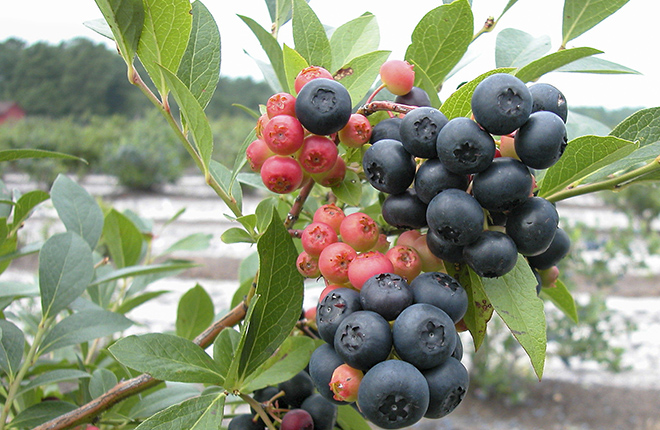A New Blueberry for Home Growers
The Agricultural Research Service was awarded a plant patent for Nocturne, a new blueberry cultivar. The new blueberry was developed at ARS’s Genetic Improvement of Fruits and Vegetables Laboratory in their satellite location at the Philip E. Marucci Center for Blueberry and Cranberry Research and Extension in Chatsworth, New Jersey.
The blueberry cross that produced Nocturne was made by plant geneticist Mark Ehlenfeldt at the center in 1993, and the plant was subsequently selected and evaluated from 1996 to 2011. Nocturne, tested under the name “US 1056,” is a cross of US 874 (a mixed species hybrid) and Premier (a commercial rabbiteye blueberry). This cross incorporates germplasm from three different blueberry species, including one with extreme cold hardiness, Vaccinium constablaei.
Nocturne is a vigorous, winter-hardy, black-fruited, blueberry selection with significant rabbiteye blueberry ancestry. “This variety is intended to be a specialty market plant for homeowner, landscape, and ornamental use,” says Ehlenfeldt. “Nocturne is especially notable for having a winterhardiness comparable to northern highbush blueberry cultivars and being slow to break dormancy in spring, making it unlike any other rabbiteye blueberry hybrids currently available.”
Nocturne bears fruit reliably in New Jersey, averaging 12 pounds per plant. It is highly self-fertile, meaning it does not require another blueberry variety to cross-pollinate it, but yield and size are likely to be improved by cross-pollination. Unripe fruit is vivid red-orange, providing attractive landscape interest. Ripe fruit is black, sweet, and medium-sized, with a flavor atypical of either rabbiteye or highbush. Fruit ripens in late midseason to late season. The scar quality—how cleanly the fruit separates from the stem—is fair, and the fruit has only moderate firmness, so Nocturne is not recommended for storage or shipping.
“All of these characteristics were documented from 7-year-old plants in typical blueberry soil in Chatsworth, New Jersey,” says Ehlenfeldt. “The plants were provided with overhead irrigation and fertilized according to commercial standards.”—By Sharon Durham, Agricultural Research Service Information Staff.
“A New Blueberry for Home Growers” was published in the June 2015 issue of AgResearch Magazine.
Key Facts
- New winter-hardy blueberry called “Nocturne”.
- Black, medium-size, sweet fruit.
- Slow to break dormancy in spring.
- Ripens in late midseason to late season.
- Averages 12 pounds of fruit per plant in New Jersey.
Full Story







